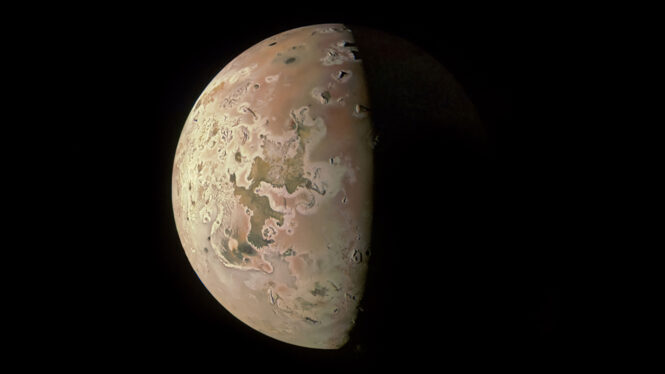
The orbiter has performed 56 flybys of Jupiter and documented close encounters with three of the gas giant’s four largest moons.
NASA’s Juno spacecraft will on Tuesday, Dec. 30, make the closest flyby of Jupiter’s moon Io that any spacecraft has made in over 20 years. Coming within roughly 930 miles (1,500 kilometers) from the surface of the most volcanic world in our solar system, the pass is expected to allow Juno instruments to generate a firehose of data.
“By combining data from this flyby with our previous observations, the Juno science team is studying how Io’s volcanoes vary,” said Juno’s principal investigator, Scott Bolton of the Southwest Research Institute in San Antonio, Texas. “We are looking for how often they erupt, how bright and hot they are, how the shape of the lava flow changes, and how Io’s activity is connected to the flow of charged particles in Jupiter’s magnetosphere.”
A second ultra-close flyby of Io is scheduled for Feb. 3, 2024, in which Juno will again come within about 930 miles (1,500 kilometers) of the surface.
The spacecraft has been monitoring Io’s volcanic activity from distances ranging from about 6,830 miles (11,000 kilometers) to over 62,100 miles (100,000 kilometers), and has provided the first views of the moon’s north and south poles. The spacecraft has also performed close flybys of Jupiter’s icy moons Ganymede and Europa.

“With our pair of close flybys in December and February, Juno will investigate the source of Io’s massive volcanic activity, whether a magma ocean exists underneath its crust, and the importance of tidal forces from Jupiter, which are relentlessly squeezing this tortured moon,” said Bolton.
Now in the third year of its extended mission to investigate the origin of Jupiter, the solar-powered spacecraft will also explore the ring system where some of the gas giant’s inner moons reside.
Picture This
All three cameras aboard Juno will be active during the Io flyby. The Jovian Infrared Auroral Mapper (JIRAM), which takes images in infrared, will be collecting the heat signatures emitted by volcanoes and calderas covering the moon’s surface. The mission’s Stellar Reference Unit (a navigational star camera that has also provided valuable science) will obtain the highest-resolution image of the surface to date. And the JunoCam imager will take visible-light color images.
JunoCam was included on the spacecraft for the public’s engagement and was designed to operate for up to eight flybys of Jupiter. The upcoming flyby of Io will be Juno’s 57th orbit around Jupiter, where the spacecraft and cameras have endured one of the solar system’s most punishing radiation environments.
“The cumulative effects of all that radiation has begun to show on JunoCam over the last few orbits,” said Ed Hirst, project manager of Juno at NASA’s Jet Propulsion Laboratory in Southern California. “Pictures from the last flyby show a reduction in the imager’s dynamic range and the appearance of ‘striping’ noise. Our engineering team has been working on solutions to alleviate the radiation damage and to keep the imager going.”
More Io, Please
After several months of study and assessment, the Juno team adjusted the spacecraft’s planned future trajectory to add seven new distant Io flybys (for a total of 18) to the extended mission plan. After the close Io pass on Feb. 3, the spacecraft will fly by Io every other orbit, with each orbit growing progressively more distant: The first will be at an altitude of about 10,250 miles (16,500 kilometers) above Io, and the last will be at about 71,450 miles (115,000 kilometers).
The gravitational pull of Io on Juno during the Dec. 30 flyby will reduce the spacecraft’s orbit around Jupiter from 38 days to 35 days. Juno’s orbit will drop to 33 days after the Feb. 3 flyby.
After that, Juno’s new trajectory will result in Jupiter blocking the Sun from the spacecraft for about five minutes at the time when the orbiter is at its closest to the planet, a period called perijove. Although this will be the first time the solar-powered spacecraft has encountered darkness since its flyby of Earth in October 2013, the duration will be too short to affect its overall operation. With the exception of the Feb. 3 perijove, the spacecraft will encounter solar eclipses like this during every close flyby of Jupiter from now on through the remainder of its extended mission, which ends in late 2025.
Starting in April 2024, the spacecraft will carry out a series of occultation experiments that use Juno’s Gravity Science experiment to probe Jupiter’s upper atmospheric makeup, which provides key information on the planet’s shape and interior structure.
More About the Mission
JPL, a division of Caltech in Pasadena, California, manages the Juno mission for the principal investigator, Scott J. Bolton, of the Southwest Research Institute in San Antonio. Juno is part of NASA’s New Frontiers Program, which is managed at NASA’s Marshall Space Flight Center in Huntsville, Alabama, for the agency’s Science Mission Directorate in Washington. Lockheed Martin Space in Denver built and operates the spacecraft.
More information about Juno is available at:
News Media Contacts
DC Agle
Jet Propulsion Laboratory, Pasadena, Calif.
818-393-9011
agle@jpl.nasa.gov
Karen Fox / Alana Johnson
NASA Headquarters, Washington
301-286-6284 / 202-358-1501
karen.c.fox@nasa.gov / alana.r.johnson@nasa.gov
Deb Schmid
Southwest Research Institute, San Antonio
210-522-2254
dschmid@swri.org
2023-188







